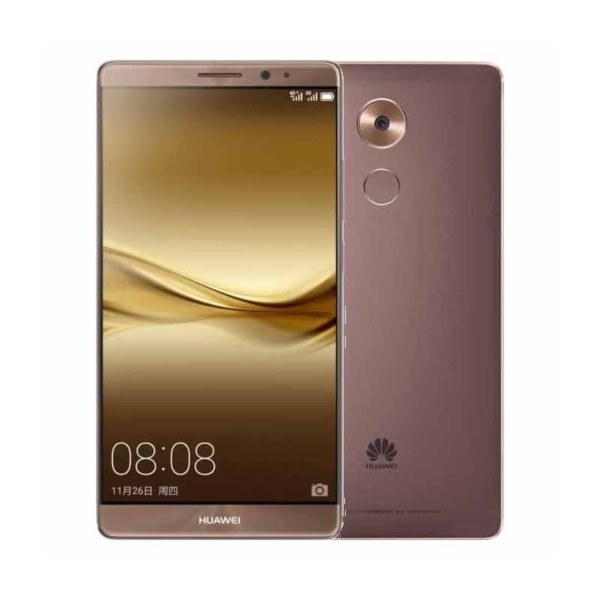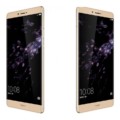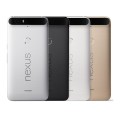- Home
- List of devices
- Huawei
- Huawei Mate 8
Huawei Mate 8


-
CPU:
-
RAM:
-
Storage:
-
Display:
-
Camera:
-
OS:
The Huawei Consumer Business Group (BG) unveiled the Huawei Mate 8, its most advanced flagship smartphone that combines beauty and practicality with a metallic, seamless design, 6-inch FHD screen and Huawei’s latest chipset architecture, the Kirin 950. As the latest innovation from Huawei’s Mate series, the Mate 8 features a customizable, next-generation Huawei EMUI 4.0 operating system based on Android M (6.0). Its body is made from aerospace-grade aluminum and unique 2.5D curved diamond cut glass, delivering an optimal design effect.
The Mate 8 is currently available in China. Huawei Mate 8 will be unveiled at CES 2016, and will be available in other regions starting from Q1 2016.
Additional specifications and features include:
- Refined Look and Feel – In addition to its smooth, curved interior, the Mate 8 also includes an 83 percent screen-to-body ratio, slimmer dimensions and wider color range display, which covers 95 percent of NTSC gamut. Users will be able to further personalize their experience with the choice of four colors: Champagne Gold, Moonlight Silver, Space Gray and Mocha Brown.
- High-performance, Low-power Consumption – The Mate 8 is the first smartphone to run on Huawei’s recently announced Kirin 950 chipset and use TSMC 16 nm FinFET plus chip technology. The leading-edge architecture features redefined properties that achieve balanced power consumption with 4 x A72 2.3 GHz processors and 4 x A53 1.8 GHz processors.
- Revolutionary i5 Intelligent Processor – The Mate 8’s i5 intelligent processor is the most powerful coprocessor currently available. It supports speech recognition, low-power consumption MP3, all the functions of a sensor hub, fused location provider (FLP) navigation, and reduces location-based power consumption.
- New Intelligent Features – Some of the Mate 8’s most notable features include voice controls, a power-saving firewall, a defragmenter and eRecovery. The smartphone also offers improved roaming, navigation and payment capabilities.
Specs
General
| Price | From ¥2999-3199, China only |
| Announced | 26 November, 2015 |
| Released | 26 November, 2015 |
| Status | Available |
Display
| Display Type <strong>Display Technology => </strong> A number of display technologies and types used in mobile phones => TFT (Thin Film Transistor), IPS (In-Place Switching), OLED (Organic Light Emitting Diode), AMOLED (Active-Matrix Organic Light-Emitting Diode), Super AMOLED (an even advanced version of AMOLED), Resistive Touchscreen (Resistive touchscreens contain two layer of conductive material with a very small gap between them which acts as a resistance), Capacitive Touchsceen (Capacitive touchscreen technology consists of a layer of glass coated with a transparent conductor) | IPS LCD |
| Size | 6 |
| Resolution | 1080 x 1920 |
| Pixel Density <strong>Pixel Density (PPI)</strong> is refers to the concentration of pixels on a particular display, measured in pixels per inch (ppi). Pixel density is calculated by dividing the diagonal pixel resolution of a display by its diagonal size, higher pixel density better display quality. | 367 ppi |
| Secondary Display | None |
Hardware
| Chipset <strong>Chipset</strong> is a group of integrated circuits designed to perform one or a more dedicated functions, often with real time computing constraints, Popular smartphones are equipped with more advanced embedded chipsets that can do many different tasks depending on their programming. | Huawei Kirin 950 |
| CPU <strong>CPU</strong> (Central Processing Unit) mostly known as processors, CPU processes instructions in order to carry out certain functions that make your device operate properly. Processors are often described as the brain of computers, smartphones and tablets, Smartphones and tablets rely on processors to carry out their every task, Processors are an incredibly important factor in selecting any type of computing device, including your smartphone. | Quad-core 2.0 GHz Cortex A57 + quad-core 2.4 GHz Cortex-A72 + i5 coprocessor |
| GPU <strong>GPU</strong> (Graphics Processing Unit) is a single-chip processor designed to rapidly manipulate and alter memory to accelerate the creation of images in a frame buffer intended for output to a display, This includes things such as lighting effects, object transformations, and 3D motion. | Mali-T880MP4 |
| RAM (Memory) <strong>RAM</strong> (Random Access Memory) is a type of computer memory that can be accessed randomly, any byte of memory can be accessed without touching the preceding bytes that allows information to be stored and accessed quickly from random locations. RAM is the most common type of memory found in computer systems, smartphones, tablets and other electronic devices. | 3GB / 4GB |
| Internal Storage <strong>Internal Storage</strong> is a data storage space (flash memory) mostly used in smartphones, tablets and other electronic devices where operating system, apps, music, photos, videos, files and other user data Is stored. | 32GB / 64GB / 128GB |
| Card Slot <strong>Memory Card Slot</strong> is a special slot for inserting a memory card. Memory cards allow you to expand the phone's built-in memory, A memory card (sometimes called a flash memory card or a storage card) is a small storage medium used to store data such as text, pictures, audio, and video, for use on small, portable or remote computing devices such as mobile phones, mp3 players, digital cameras. | yes |
| Sensors <strong>Sensors</strong> are electronic components that detects and responds to some type of input from the physical environment. The specific input could be light, heat, motion, moisture, pressure and location, The output is generally a signal that is converted to use in computing systems, a location sensor, such as a GPS receiver is able to detect current location of your electronic device. | Fingerprint Sensor, G-Sensor, Gyroscope sensor, Compass, Ambient Light Sensor, Proximity sensor, Hall sensor, Barometer |
Battery
| Battery Type <strong>Battery Type => </strong> Cell phones run on various kinds of batteries depending on the manufacturer, phone size or shape and features. There are basically four types of cell phone batteries => Lithium Polymer, Lithium Ion, Nickel Metal Hydride and Nickel Cadmium. | Li-Ion (Lithium Ion) |
| Capacity <strong>Battery Capacity</strong> is a measure (typically in Amp-hr) of the charge stored by the battery, and is determined by the mass of active material contained in the battery. The battery capacity represents the maximum amount of energy that can be extracted from the battery under certain conditions. | 4000mAh |
| Fast Charging | Yes, 37% in 30 minutes |
Camera
| Primary <strong>Camera</strong> is able to capture photographs and usually videos, The most important characteristics of a camera are the resolution (measured in megapixels), lens focus type (fixed or automatic), higher megapixel cameras are known to capture higher quality photos, but not always a good measurement of the photos quality. | 16mp |
| Camera Features |
Sony IMX298 Sensor w/ 1.12µm pixels F/2.0 aperture Optical image stablization PDAF+CAF auto focus BSI CMOS |
| Secondary | 8mp f/2.4 aperture |
| Image | 4608 x 3456 pixels |
| Video | 1080p, 60 fps |
| Flash <strong>Flash Light => </strong> There is commonly two types of flash lights are used in camera mobile phones, LED Flash (LED flash offers lower power consumption with drive circuitry that takes up very little room, LEDs can be strobed faster than any other light source), Xenon Flash (xenon flash produces an extremely intense full-spectrum white light for a very short duration) | Yes |
Design
| Type <strong>Design Type</strong> called form factor refers to a mobile phone's size, shape, and style as well as the layout and position of major components of phone. There are three major form factors seen in mobile phones => bar phones, folding phones and sliding phones. | Bar |
| Dimensions | 157.1mm * 80.6mm * 7.9mm |
| Weight | 185 grams |
| Protection |
Metallic Unibody Design 2.5D Diamond cut glass |
| Colors |
Moonlight Silver Space Grey Champagne Gold Mocha Brown |
Network
| SIM <strong>SIM</strong> (Subscriber Identity Module) is a small card that contains mobile network subscriber's account information. This allows the phone using the card to attach to a mobile network. The SIM card is most commonly associated with GSM and UMTS mobile networks. Moving a SIM card from one phone to another allows a subscriber to switch mobile phones without having to contact their mobile network carrier. SIM cards can also be used by a phone to store limited amounts of data, such as phone numbers and text messages. | Nano SIM |
| Dual SIM | Yes |
| 2G Network | Yes |
| 3G Network | Yes |
| 4G Network | Yes |
Software
| Operating System <strong>OS => </strong> Every computer system run on a base software called Operating System (OS). Operating System controls all basic operations of the computer (such as smartphone, PDAs, tablet computers and other handheld devices). The Operating System allows the user to install and run third party applications (apps), apps are used to add new functionality to the device. | Android 6.0 Marshmallow |
| User Interface <strong>UI</strong> or user interface of a device is the look and feel of the on-screen menu system. How it works, its color scheme, how it responds to button presses, all of these things are part of the user interface. | EmotionUI 4.0 |
Connectivity
| Bluetooth <strong>Bluetooth</strong> is a wireless communications technology for exchanging data between mobile phones, headsets, computers and other network devices over short distances without wires, Bluetooth technology was primarily designed to support simple wireless networking of personal consumer devices. | v4 |
| Infrared <strong>Infrared</strong> connectivity is an old wireless technology used to connect two electronic devices. It uses a beam of infrared light to transmit information and so requires direct line of sight and operates only at close range. | |
| Wi-fi <strong>Wi-Fi</strong> is a popular wireless networking technology using radio waves to provide high-speed network connections that allows devices to communicate without cords or cables, Wi-Fi is increasingly becoming the preferred mode of internet connectivity all over the world. | 802.11b/g/n |
| USB | v2.0 |
| GPS <strong>GPS</strong> The Global Positioning System is a satellite-based radio navigation system, GPS permits users to determine their position, velocity and the time 24 hours a day, in all weather, anywhere in the world, In order to locate your position, your device or GPS receiver must have a clear view of the sky. | Yes |
| NFC <strong>NFC</strong> (Near field communication) is a set of standards for smartphones and similar devices to establish peer-to-peer radio communications with each other by touching them together or bringing them into proximity, usually no more than a few inches. |



